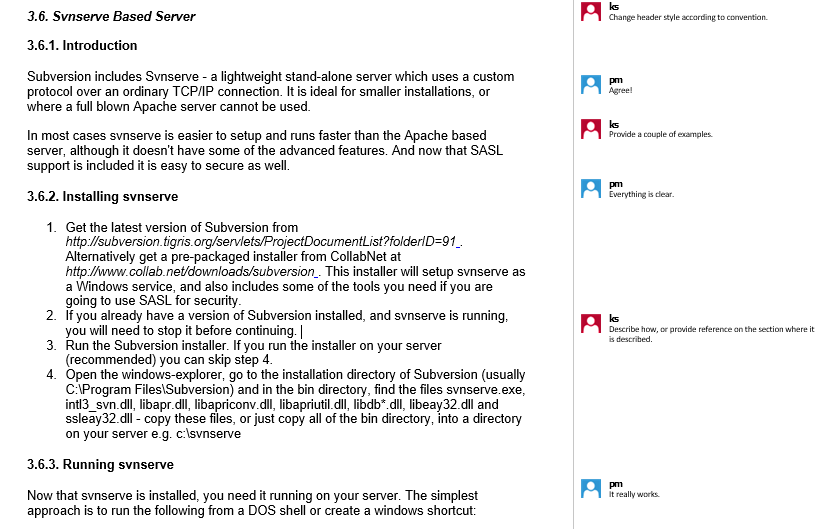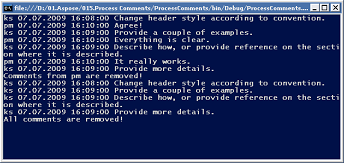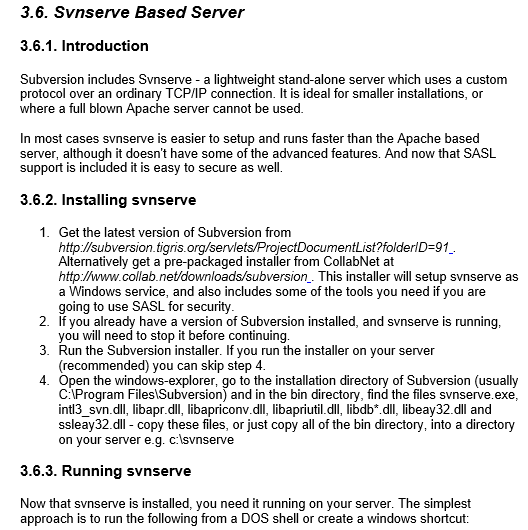Analyzing your prompt, please hold on...
An error occurred while retrieving the results. Please refresh the page and try again.
オンラインで試す
あなたは私たちのこの機能を試すことができます 無料オンライン注釈を削除.
Aspose.Wordsはユーザーがコメントを操作できるようにします–Aspose.Wordsのドキュメント内のコメントはCommentクラスで表されます。 また、CommentRangeStartクラスとCommentRangeEndクラスを使用して、コメントに関連付けるテキストの領域を指定します。
Aspose.Wordsでは、いくつかの方法でコメントを追加できます:
次のコード例は、Commentクラスを使用して段落にコメントを追加する方法を示しています:
次のコード例は、テキストの領域とCommentRangeStartクラスとCommentRangeEndクラスを使用して段落にコメントを追加する方法を示しています:
Word文書でコメントを使用する(変更の追跡に加えて)ことは、文書をレビューするとき、特に複数のレビュー担当者がいる場合に一般的な方法です。 あなたが文書から必要とする唯一のものがコメントである状況があるかもしれません。 レビュー結果のリストを生成したい場合や、ドキュメントからすべての有用な情報を収集し、不要なコメントを削除したい場合などです。 特定のレビュー担当者のコメントを表示または削除することができます。
このサンプルでは、ドキュメント内のコメントから情報を収集し、ドキュメントからコメントを削除するための簡単な方法をいくつか見ていきます。 具体的には、次の方法について説明します:
このサンプルのコードは非常に単純で、すべてのメソッドは同じアプローチに基づいています。 Word文書内のコメントは、Aspose.Wordsドキュメントオブジェクトモデル内のCommentオブジェクトによって表されます。 ドキュメント内のすべてのコメントを収集するには、最初のパラメータをNodeType.Commentに設定したgetChildNodesメソッドを使用します。 getChildNodesメソッドの2番目のパラメータがtrueに設定されていることを確認してください:これにより、getChildNodesは直接の子のみを収集するのではなく、すべての子ノードか
ドキュメントからコメントを抽出して削除する方法を説明するために、次の手順を実行します:
この演習では、次のWord文書を使用します:

ご覧のとおり、イニシャル「pm」と「ks」を持つ2人の著者からのいくつかのコメントが含まれています。
getChildNodesメソッドは非常に便利で、任意のタイプのドキュメントノードのリストを取得する必要があるたびに使用できます。 このコレクション内の項目を列挙またはアクセスする場合にのみ、ノードがこのコレクション内で選択されるため、結果のコレクションでは即時オーバ
次のコード例は、ドキュメント内のすべてのコメントの作成者名、日付と時刻、およびテキストを抽出する方法を示しています:
コレクションにコメントノードを選択したら、必要な情報を抽出するだけです。 このサンプルでは、著者のイニシャル、日付、時刻、およびコメントのプレーンテキストが1つの文字列に結合されています。代わりに、他の方法で保存することもできます。
特定の著者からコメントを抽出するオーバーロードされたメソッドはほぼ同じですが、配列に情報を追加する前に著者の名前をチェックするだけです。
次のコード例は、指定された作成者によるコメントの作成者名、日付と時刻、およびテキストを抽出する方法を示しています:
すべてのコメントを削除する場合は、コメントを1つずつ削除するコレクション内を移動する必要はありません。commentsコレクションでclearを呼び出すことで、それらを削除できます。
次のコード例は、ドキュメント内のすべてのコメントを削除する方法を示しています:
コメントを選択的に削除する必要がある場合、プロセスはコメント抽出に使用したコードに似たものになります。
次のコード例は、指定した作成者によるコメントを削除する方法を示しています:
ここで強調する主なポイントは、for演算子の使用です。 単純な抽出とは異なり、ここではコメントを削除します。 適切なトリックは、最後のコメントから最初のコメントまでコレクションを逆方向に反復することです。 この理由最後から開始して後方に移動すると、前の項目のインデックスは変更されず、コレクション内の最初の項目に戻ることができます。
次のコード例は、コメントの抽出と削除のメソッドを示しています:
起動すると、サンプルには次の結果が表示されます。 まず、すべての著者によるすべてのコメントを一覧表示し、次に選択した著者によるコメントのみを一覧表示します。 最後に、すべてのコメントを削除するコード。

出力Word文書からコメントが削除されました:

Aspose.Wordsを使用すると、CommentRangeStartノードとCommentRangeEndノードの間のコメントを削除することもできます。
次のコード例は、CommentRangeStartとCommentRangeEndの間のテキストを削除する方法を示しています:
addReplyメソッドはこのコメントに返信を追加します。 既存のMSオフィスの制限により、文書内では1つのレベルの返信のみが許可されていることに注意してください。 このメソッドが既存の返信コメントに対して呼び出されると、タイプInvalidOperationExceptionの例外が発生します。
このコメントに対する指定された返信を削除するには、removeReplyメソッドを使用できます。
次のコード例は、コメントに返信を追加し、コメントの返信を削除する方法を示しています:
Aspose.Wordsコメントの返信を読むためのサポート。 Repliesプロパティは、指定されたコメントの直接の子であるCommentオブジェクトのコレクションを返します。
次のコード例は、コメントの返信を反復処理して解決する方法を示しています:
Analyzing your prompt, please hold on...
An error occurred while retrieving the results. Please refresh the page and try again.